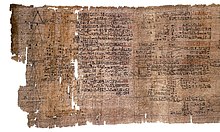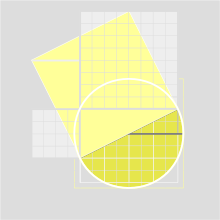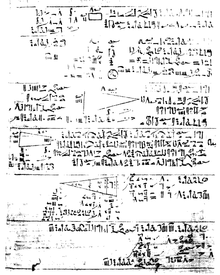Papyrus Rhind


The Papyrus Rhind is an ancient Egyptian treatise written on papyrus on various mathematical topics that we now call arithmetic , algebra , geometry , trigonometry and fractions . Along with the somewhat older, but less extensive Papyrus Moscow 4676, it is considered to be one of the most important sources for our knowledge of mathematics in ancient Egypt and dates back to around 1550 BC. Dated.
discovery
The Papyrus Rhind is named after the Scottish lawyer and antiquarian Alexander Henry Rhind , who bought it in Luxor , Upper Egypt in 1858 . The documents were probably found a little before during illegal excavations in the area of Thebes, west of the Nile opposite Luxor, in or near the Ramesseum , more precise circumstances are not known.
Details
The papyrus was probably made in the 16th century BC. It was made during the Second Intermediate Period - initially the 33rd year of reign of Apopi , a king of the 15th Hyksos dynasty , is given as the date - and is largely regarded as a copy of a papyrus over two centuries older, which is probably from the reign of Amenemhet III. the 12th dynasty in the Middle Kingdom . The copyist - a scribe named Ahmose , also Ahmes after an earlier transcription - used the hieratic script and highlighted some values and listed procedures with red instead of black ink, such as sets of dividers.
Today the papyrus is only available in the form of fragments of a scroll over 5 meters long and about 32 cm wide, which is written on both sides. In British Museum two pieces of 295.5 cm and 199.5 cm length are kept (1865 inventoried with No. 10057 or 10,058th); the gap between the two is estimated to be approximately 18 cm. In addition to some tables, the papyrus gives a number of different mathematical problems with exemplary solutions; depending on the counting method, there are a total of 84 or 87 or 91 tasks. The text could only be deciphered and translated at the end of the 19th century AD; its mathematical statements have been deciphered and made accessible since the beginning of the 20th century.
In terms of content, the manuscript can be divided into three sections. After the title, at the beginning of the first part there is a longer table that shows the fraction 2 / n as a sum of original fractions for all odd numbers n from 3 to 101 , followed by a short table for n from 2 to 9 of the fraction n / 10 . Then 40 arithmetic and algebraic problems are covered. The second part presents 20 geometrical problems and deals with the volume and area of different figures as well as the relationship of height to side of the body of a pyramid as its inclination. Two dozen other problems make up the third part, in addition to calculations relating to the production of bread and beer as well as to the feeding of poultry and cattle, a puzzle about cats and mice is given here .
Approximate value for the area of a circle
The problems dealt with in the second part of the Rhind Papyrus also include calculating the area of a circle. In the 48th task, Ahmes describes how he calculates the area of a circle inscribed in a square . From today's perspective, this can be interpreted as an approximation of the number of circles . On the basis of the calculation rule given in the papyrus next to a sketch (see fourth and fifth illustration from above), Kurt Vogel reconstructed the underlying considerations in 1928.
Ahmes first divides the sides of the square into thirds and thus wins nine equal, smaller squares with sides of 3 units. Then he cuts off half of the four corner cells and comes across the figure of an irregular octagon. This octagon is made up of five full and four half squares for the total area of 7 of the small squares, each with 3 2 = 9 units of area and thus has the area of 7 • 9 = 63 square units. Obviously it is only slightly smaller than the circle - for its area Ahmes therefore assumes the content of 64 = 8 • 8 square units, which is not smaller.
Thus, the area of a circle with diameter 9 is set equal to the area of a square with side length 8. This results in approximately for the content of the circular area with the radius of 9 / 2
- over
- so and thus approximately
The value determined in this way misses the number ( pi ) in absolute terms by about 0.01890 and relatively by less than one percent (0.602%). In the ancient Egyptian number system, this value is not represented as a decimal, but as a sum of original fractions:
For the procedure reproduced in the Rhind Papyrus, the approximation to the number of circles can be calculated from the ratio of the area of an inscribed circle and its circumscribing square,
- there , so then and thus
The circle inscribed on a square with 81 area units actually encompasses about 63,617 area units. As an approximation , the method described by Ahmes relates a circle to a square of 9 • 9, mediates it via an octagonal figure and equates its area to a square of 8 • 8 - which can probably be seen as an early attempt to square the circle . The surface equality of a square with a circular area was therefore presumed when the side length of 8 / 9 is their diameter, so one-ninth is lower.

In the case of an 8 × 8 square, with 64 units of area, the circle diameter measures approximately 9 units of length.
But the reference to the contours of a figure in an orthogonal network of lines was already familiar to the ancient Egyptian stonemasons, in order to transfer a design proportionally based on the relationships of intersection points onto the stone surface to be worked. Against this background, Hermann Engels presented a different assumption in 1977, which could explain the approximate ratio given here based on the grid of grid squares. Then one would intuitively draw a circle C (with diameter d ) in such a way that its center is that of a roughly equal square F (with side length a ) made up of 4 × 4 partial squares, which is intersected eight times by this circle at the quarter points of its sides. With the transition to an even finer subdivision of F (into 8 × 8 uniform sub-squares), the content of the square F is therefore 64 such area units, while the content of the circle is actually about 62.8 area units - and a square U with 80 area units can be written exactly is - because
- the triangle center point-bisection point-quarter point sets circle radius and square side in the relationship and
- with for the diameter results
- off then
- for units of length thus for units of area,
- as well as for , so respectively

A comparison of the (gray and yellow) partial areas may suggest that this square is equal in area to the sum of the square F (64) plus a 4 × 4 square (16) - Pythagoras was aware of this relationship.
In the case of an erroneous assumption that the area of the circle C would be equal to the square F, the error for the indication of the area of the circle (“64 units”) is just under two percent (1.825%). If, on the other hand, you consider the actual content of the constructed circular area and then take into account the relationship between side length and diameter,
- in result , therefore , approximately with the estimate to be content, we missed so by about 1,234% - exactly 1 / 81 - because instead of 20 area units.
If one then applies for the approximate value of described above , the actual area of (≈ 62.832) is estimated somewhat too high with the approximation - but the result now corresponds to the wrong assumption: “64 units”.
In this way, looking at a circle in a square network, as was customary for the transfer of designs to surfaces to be worked on, would be obtained in a very simple way - with incorrect assumptions and rough dimensions - a simple calculation rule for the circular area: “Reduce that Circle diameter around a ninth, so you get the side of the square. ”- which often applies surprisingly well.
The estimated ratio of is also used in problem 41 (see third figure from above, enlarged) of the Rhind papyrus, where it is a matter of calculating the volume of a cylindrical granary. It is also assumed in the calculation rule for the area of a curved surface, which is reproduced in problem 10 of the older Moscow Papyrus 4676 ; here, however, the interpretations differ as to which area is meant exactly.
Repository
The two main pieces of the Papyrus Rhind or Rhind Mathematical Papyrus (RMP), a nearly 3 m and a nearly 2 m long fragment, have been in the possession of the British Museum in London since 1865 , recorded under the inventory numbers pBM 10057 and pBM 10058, respectively The missing intermediate piece (almost 0.2 m) has preserved some smaller fragments that were not acquired by Rhind at the time and are now kept in the Brooklyn Museum in New York .
See also
- Papyri Lahun / Kahun
- History of mathematics
- Mathematics in Ancient Egypt
- List of papyri of ancient Egypt
expenditure
- August Eisenlohr : A mathematical manual of the ancient Egyptians (Papyrus Rhind of the British Museum). 2 volumes, Hinrichs, Leipzig 1877 ( online ).
- Thomas Eric Peet: The Rhind Mathematical Papyrus, British Museum 10057 and 10058. Hodder & Stoughton for The University Press of Liverpool, London 1923.
- Arnold Buffum Chace, Henry Parker Manning, Raymond C. Chace, Ludlow Bull: The Rhind Mathematical Papyrus: British Museum 10057 and 10058. 2 volumes, Mathematical Association of America, Oberlin [OH], 1927/1929 . (Shortened new edition: National Council of Teachers of Mathematics, Reston [OH] 1979, ISBN 0-87353-133-7 ).
- Gay Robins, Charles Shute: The Rhind Mathematical Papyrus. An Ancient Egyptian Text . British Museum, London 1987, ISBN 0-7141-0944-4 (with photos of the papyrus).
literature
- Marshall Clagett: Ancient Egyptian Science: A Source Book. Vol. 3: Ancient Egyptian Mathematics. (Memoirs of the American Philosophical Society. No. 232) American Philosophical Society, Philadelphia 1999, ISBN 0-87169-232-5 .
- Milo Gardner: An Ancient Egyptian Problem and its Innovative Arithmetic Solution. In: Ganita Bharati: Bulletin of the Indian Society for the History of Mathematics. Vol. 28, MD Publications, New Delhi 2006, pp. 157-173.
- Richard Gillings: Mathematics in the time of the pharaohs. MIT Press, Dover 1982
- Annette Imhausen : Egyptian Algorithms. An investigation into the central Egyptian mathematical problem texts. Harrassowitz, Wiesbaden 2003, ISBN 3-447-04644-9 .
- Franz von Krbek : Captured Infinity. 2nd edition, Geest & Portig, Leipzig 1952, pp. 79 ff.
- Neil MacGregor : A History of the World in 100 Objects . Translated from the English by Waltraut Götting. Andreas Wirthensohn, Annabell Zettel, CH Beck, Munich 2011, ISBN 978-3-406-62147-5 , pp. 141-149.
Web links
- Rhind Mathematical Papyrus - Article with illustrations of the papyrus fragments on the British Museum site.
- Eric W. Weisstein: Rhind Papyrus . MathWorld – A Wolfram Web Resource. Retrieved January 29, 2011.
- O'Connor and Robertson: Mathematics in Egyptian Papyri .
- Scott W. Williams: Egyptian Mathematics Papyri .
- RMP 2 / n Table from the English Wikipedia
Individual evidence
- ↑ a b c d The Rhind Papyrus . in the collection of the British Museum . Retrieved July 20, 2020 .
- ^ A b Annette Imhausen: Mathematics in Ancient Egypt: A Contextual History. Princeton University Press 2020, ISBN 978-0-691-20907-4 , pp. 65 f. google book
- ↑ compare the photographic reproduction of this part of the Rhind mathematical papyrus on the British Museum website.
- ↑ see K. Vogel: Vorgiechische Mathematik. Part I: Prehistory and Egypt. In the series of mathematical study books. Schroedel, Hannover 1958, p. 66.
- ^ A b H. Engels: Quadrature of the circle in ancient Egypt. In: Historia Mathematica , Volume 4, No. 2, 1977, pp. 137-140; DOI: 10.1016 / 0315-0860 (77) 90104-5 .
- ^ Hans Wußing : 6000 years of mathematics. Springer, Berlin 2008, ISBN 978-3-540-77189-0 , pp. 120f ( limited online version (Google Books) ).
- ^ Fragments of Rhind Mathematical Papyrus . online in the collection of the Brooklyn Museum . Retrieved August 29, 2016 .






























